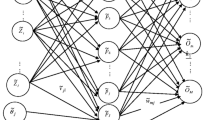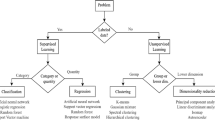Abstract
This article uses powerful technique of artificial neural network (ANN) models to simulate and estimate structural response of two-storey shear building by training the model for a particular earthquake. The neural network is first trained for a real earthquake data and the numerically generated responses of different floors of two-storey buildings as the training patterns. Trained ANN architecture is then used to simulate and test the structural response of different floors for various intensity earthquake data and it is found that the predicted responses given by ANN model are good for practical purposes. It is worth mentioning that although the simulation is done with numerically generated response data for particular earthquake, the idea may also be used for actual experimental (response) data.






Similar content being viewed by others
References
Wu X, Ghaboussi J, Garett JH (1992) Use of neural networks in detection of structural damage. Comput Struct 42(4):649–659. doi:10.1016/0045-7949(92)90132-J
Elkordy MF, Chang KC, Lee GC (1993) Neural networks trained by analytically simulated damage states. J Comput Civ Eng 7(2):130–145. doi:10.1061/(ASCE)0887-3801(1993)7:2(130)
Pandey PC, Barai SV (1995) Multilayer perceptron in damage detection of bridge structures. Comput Struct 54(4):597–608. doi:10.1016/0045-7949(94)00377-F
Zhao J, Ivan JN, DeWolf JT (1998) Structural damage detection using artificial neural networks. J Infrastruct Syst 4(3):93–101. doi:10.1061/(ASCE)1076-0342(1998)4:3(93)
Masri SF, Smyth AW, Chassiakos AG, Chassiakos AG, Caughey TK, Hunter NF (2000) Application of neural networks for detection of changes in nonlinear systems. J Eng Mech 126(70):666–676. doi:10.1061/(ASCE)0733-9399(2000)126:7(666)
Rumelhart DE, Hinton GE, Williams RJ (1986) Learning international representation by error propagation. In: Rumelhart DE et al (eds) Parallel distributed processing. The MIT Press, Cambridge, MA, pp 318–362
Mathur VK, Chakraverty S, Gupta P (2004) Response prediction of typical rural house subject to earthquake motions using artificial neural network. J Indian Build Congr IBC 11(2):99–105
Newmark NM, Rosenblueth E (1971) Fundamentals of earthquake engineering. Prentice-Hall Inc., Englewood Cliffs, NJ
Chakraverty S, Marwala T, Pallavi G (2006) Response prediction of structural system subject to earthquake motions using artificial neural network. Asian J Civ Eng 7(3):301–308
Chakraverty S (2002) Neural modelling based identification methodology for structural systems. 12th Symposium on earthquake engineering, IIT Roorkee, Dec 16–18
Chakraverty S, Sharma RK, Singh VP (2003) Soft-computing approach for identification of dynamic systems. J N Build Mater Constr World 9(2):50–56
Chakraverty S, Singh VP, Sharma RK (2006) Regression based weight generation algorithm in neural network for estimation of frequencies of vibrating plates. Comput Methods Appl Mech Eng 195:4194–4202. doi:10.1016/j.cma.2005.08.008
Acknowledgements
The authors would like to thank Seismology Division, Ministry of Earth Sciences, New Delhi, India for funding to carry out this investigation and the Dept. of Earthquake Eng., IIT, Roorkee for supplying some of the data. The author also wishes to thank the anonymous reviewers for valuable suggestions.
Author information
Authors and Affiliations
Corresponding author
Rights and permissions
About this article
Cite this article
Chakraverty, S., Gupta, P. & Sharma, S. Neural network-based simulation for response identification of two-storey shear building subject to earthquake motion. Neural Comput & Applic 19, 367–375 (2010). https://doi.org/10.1007/s00521-009-0279-6
Received:
Accepted:
Published:
Issue Date:
DOI: https://doi.org/10.1007/s00521-009-0279-6




